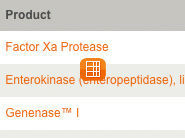
Protein Tools
Choose Type:
- What is Ph.D.™ Phage Display?
- What products has NEB developed from ongoing basic research in molecular parasitology?
- Which residues does Endoproteinase AspN cut?
- Are there any amino acid residues that inhibit or reduce the efficiency of digestion of glutamate residues in a peptide sequence with Endoproteinase GluC? The site I want to digest has a glutamate residue followed by a proline residue and some enzymes are inhibited by the presence of a proline after the hydrolysis site.
- How does one do a Trypsin in-gel digest?
- I can’t get Endoproteinase AspN to digest my protein.
- I have a very low concentration of protein and would prefer not to denature as a separate step with buffer exchange before digestion. What denaturants can he use in the Trypsin reaction itself?
- What peptide libraries are available for use with Ph.D.™ Phage Display?
- What is the Proteinase K activity in commonly used buffers?
- Labeling of Escherichia coli Expressed SNAP-tag® Fusion Proteins
- Ph.D.™ Peptide Display Cloning System
- Simultaneous Fluorescent Labeling of Proteins in Living Cells
- Intein-Mediated Protein Ligation IPL and Labeling with the IMPACT™ Kit
- Comprehensive structural and positional profiling of intact complex O-glycans in biologic drugs using O-Glycoprotease (IMPa)
-
Combating Neglected Diseases - a genomic approach to identify potential drug targets
-
Parasitic Infections in Humans
Understand the common types of parasitic infections in humans and why they are still increasing in tropical regions.
-
Applications of the Ph.D. Phage Display Peptide Libraries
- Glycoproteomics Brochure
- Glycoproteomics Technical Guide
- Glycosylation Poster
- Purification Beads, Columns and Resins Brochure
- A monoclonal antibody for transcriptome-wide N6-methyladenosine analysis (2017)
Feature Articles
Brochures
Posters
Products and content are covered by one or more patents, trademarks and/or copyrights owned or controlled by New England Biolabs, Inc (NEB). The use of trademark symbols does not necessarily indicate that the name is trademarked in the country where it is being read; it indicates where the content was originally developed. The use of this product may require the buyer to obtain additional third-party intellectual property rights for certain applications. For more information, please email busdev@neb.com.
This product is intended for research purposes only. This product is not intended to be used for therapeutic or diagnostic purposes in humans or animals.


